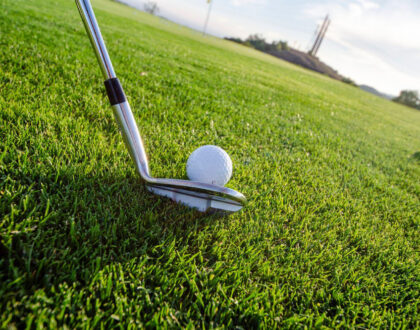Scoring a Birdie in Golf and Unraveling The History Behind The Birdie

 Source: Pexels
Source: Pexels
Even if you’re not a golf enthusiast, you’ve most certainly heard of a ‘birdie’ before. Every golfer—whether professional or amateur—wants to make a lot of birdies in a game. If you’re looking to improve your golf skills or brush up on your golf history, let’s learn what a birdie is and where the name is derived from.
Birdie in Golf Meaning
Wondering about the golf birdie meaning? Nailing a golf birdie refers to making a stroke of one score below par. Par is the number of strokes a professional golfer is expected to make on a hole. Each individual hole on a course will have its own par.
For example, to score a birdie on a 4-hole par, the player would need to do it in three strokes. As this is one stroke under the expected par, the player’s move is considered a birdie. Scoring a birdie in golf is considered a huge accomplishment for any golfer—it can often be the difference between winning and losing.
History of The Birdie
Source: Pexels
For many years, there weren’t any terms or nicknames for golf. So: where did the term birdie come from? Well, in the 20th century, Americans would use the word ‘bird’ for anything that was excellent. The apparent first use of the term in golf was in the Maclean Magazine in September of 1911—a writer referred to a golf stroke, unrelated to one under par, as ‘bird’.
But a golfer named AB Smith claims he and his brother first started using the term in 1903 and made a birdie what it is known as today. They were playing a game of golf with a friend, and AB’s brother called his stroke ‘a bird of a shot.’ He then made a bet that he could get the hole-in-one under par. The three claim they used the term ‘birdie’ from there on out when they got the hole in one stroke under par.
Then, by 1913, the term had been adopted worldwide when an English columnist wrote—‘it takes a day or two for the English onlooker (in the U.S.) to understand that a birdie is a hole done in one stroke under par.’
Tips for Scoring a Birdie
Source: Pexels
Depending on a golfer’s level of skill and what they are trying to achieve the number of birdies you want to score will vary. Most professional golfers will aim to score between 8-9 birdies in a game.
The likelihood of scoring a birdie will also heavily depend on the type of course you are playing. Some courses are designed to be more difficult, whereas others may give more opportunities to make great strokes like a birdie.
1. Use the right equipment
Make sure the clubs you are using are right for your skill level. Beginners will require different golf clubs from those a professional golfer may use.
2. Work on distance control
Understanding how far you can hit a golf ball with your club makes it easier to gauge your stroke. Work on improving your distance control and getting a feel for where the ball ends up, depending on the type of stroke.
3. Practice short game
In addition to long and powerful shots, you’ll want to practice your putting, chipping, and pitching. This will often require the most practice as you focus more on the fine details of your strokes.
4. Use your strengths
Figuring out what your strengths are in golfing and being able to utilize them to your benefit is essential. For example, if you are good at driving the ball, you can use this to position yourself to get the most out of that strength.
5. Stay positive
One of the biggest tips is to stay motivated and not let yourself feel disappointed when you don’t get the score you were hoping for. Practice builds confidence and skill. Becoming excellent at a sport takes a lot of time and dedication, so staying positive will help you to persevere.
Jordan Spieth, a professional PGA American golfer, gave some advice on how to score a birdie. One of Spieth’s biggest tips is not to overthink your stroke but to completely analyze the speed and line of the putt and work from there.
Golfers With The Best Birdie Scores
Source: Pexels
In the early 1990s, there were only a handful of players who had successfully added impressive scores to their portfolios. However, in the last six years, more professional golfers have made some incredible birdie records.
Scottie Scheffler currently holds the PGA Tour record for the most birdies in 27 rounds, amassing an impressive 148 birdies. Scheffler’s average sits at 5.48, whereas the general average sits at roughly 4.11.
What’s The Opposite of a Birdie?
Of course, getting a low and impressive score in golf is the goal. That’s why a track record of consistent birdies is great for professional golf players. On the opposite end of the spectrum, players may score a ‘bogey.’
A bogey is when a player scores the hole in one more stroke than expected by the par. So, if a par expects players to get it in the hole in four strokes, but they do it in five, that’s considered a bogey.
With a crazy name like bogey, you might be wondering where the name actually derived from. Well, in the late 19th century, Scottish and English golfers often compared the aspiration for a perfect score to the hard challenge of finding The Bogey Man. However, by the 1900s, the term ‘par’ took over for the perfect score, and bogey was the new name for a score of +1 of the par.
Conclusion
To wrap it up, let’s have a quick recap. The term ‘birdie’ refers to scoring one stroke under par on a hole. This move gives a great sense of accomplishment to professionals and amateurs alike. The term itself has some incredible history, but it seems we can attribute the invention of it to AB Smith and his golfing gang. So, next time you’re out on the golf course, see how many birdies you can score.





